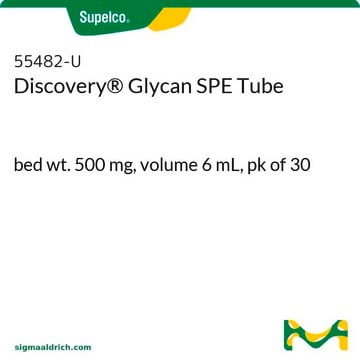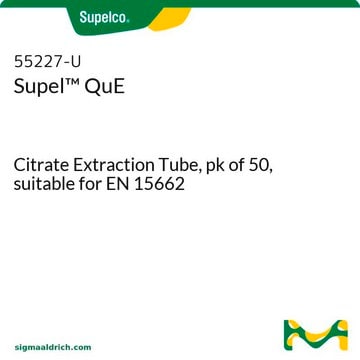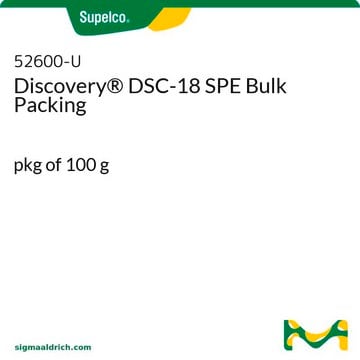55467-U
Discovery® Glycan solid phase extraction (SPE) Cartridge
bed wt. 250 mg, volume 3 mL, pk of 54
About This Item
Prodotti consigliati
Nome del prodotto
Discovery® Glycan SPE Tube, bed wt. 250 mg, volume 3 mL, pk of 54
Materiali
PE frit
polypropylene
Livello qualitativo
Composizione
bed wt., 250 mg
Confezionamento
pk of 54
tecniche
solid phase extraction (SPE): suitable
Volume
3 mL
Impurezze
<5% Water content
Matrice
polyamide resin base material
Gruppo funzionale matrice
amide, poly- phase
Dimensione particelle
50-160 μm
Intervallo di pH
4.5-7.5(surface pH)
Densità bulk
0.2‑0.3 g/mL
Tecnica di separazione
reversed phase
Cerchi prodotti simili? Visita Guida al confronto tra prodotti
Categorie correlate
Descrizione generale
Sample Matrix Compatibility: Aqueous or methanolic solutions
- Polyamide Resin: Particle Size: 50-160 μm, Surf pH: 4.5-7.5, Density: 0.2-0.3 cm3/g, Water Content: < 5 %
- Useful for extracting gylcans from aqueous solutions.
- Used to adsorb polar compounds (-OH groups, esp. phenolic compounds) from aqueous or methanolic solutions under the reversed-phase mechanism through strong hydrogen bonding between compound hydroxyl groups and amide groups of the resin
- Also may be used for the extraction of tannins, chlorophyll, humic acid, pharmacologically active terpenoids, flavanoids, gallic acid, catechol A, protocatechuic acid, phloroglucinol, aromatic carboxylic acids, and nitroaromatic compounds
- Irreversibly retains quinones.
Note legali
Codice della classe di stoccaggio
11 - Combustible Solids
Classe di pericolosità dell'acqua (WGK)
WGK 3
Punto d’infiammabilità (°F)
Not applicable
Punto d’infiammabilità (°C)
Not applicable
Scegli una delle versioni più recenti:
Certificati d'analisi (COA)
Non trovi la versione di tuo interesse?
Se hai bisogno di una versione specifica, puoi cercare il certificato tramite il numero di lotto.
Possiedi già questo prodotto?
I documenti relativi ai prodotti acquistati recentemente sono disponibili nell’Archivio dei documenti.
Articoli
Reversed-phase interaction will retain most molecules with hydrophobic character; it is very useful for extracting analytes that are very diverse in structure within the same sample.
Active Filters
Il team dei nostri ricercatori vanta grande esperienza in tutte le aree della ricerca quali Life Science, scienza dei materiali, sintesi chimica, cromatografia, discipline analitiche, ecc..
Contatta l'Assistenza Tecnica.







